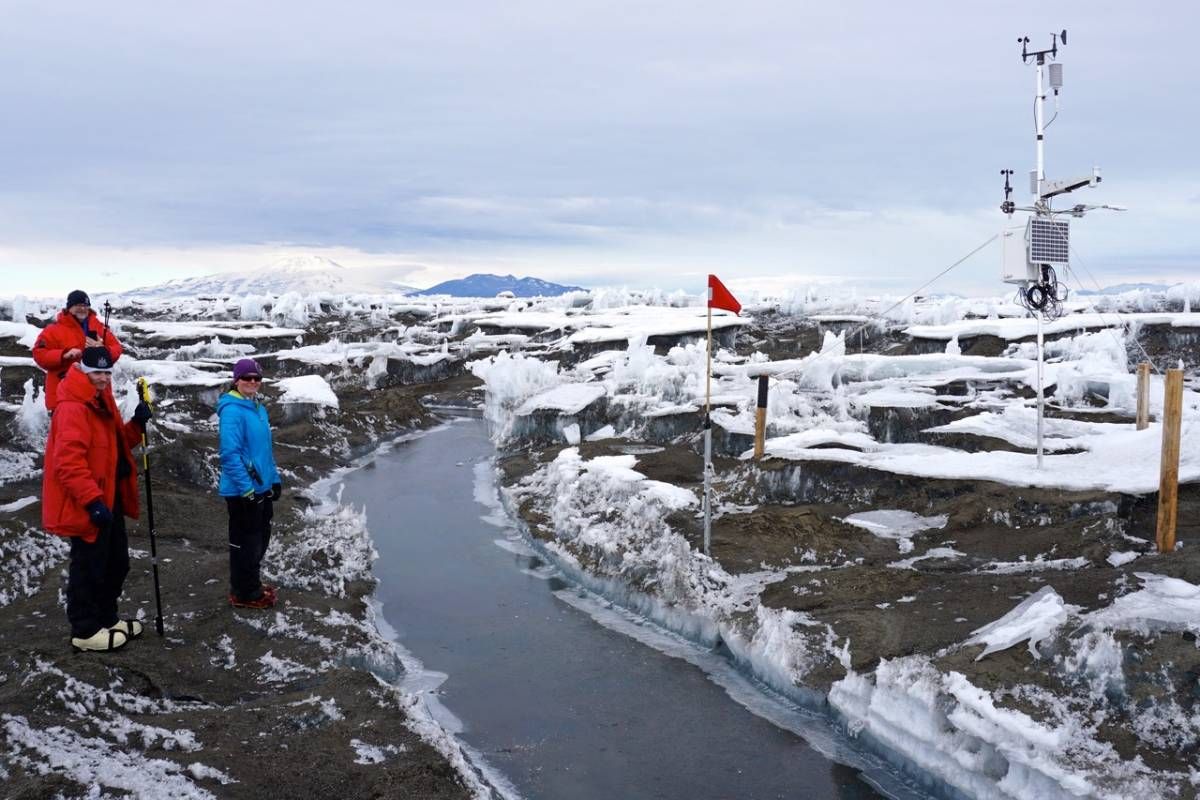Ice shelves buckle under weight of meltwater lakes
Researchers record first field measurements of Antarctic ice shelf flexure, which can lead to ice shelf break up

For the first time, a research team co-led by CIRES-based scientists has directly observed an Antarctic ice shelf bending under the weight of ponding meltwater on top, a phenomenon that may have triggered the 2002 collapse of the Larsen B ice shelf. And ice shelf flexure could potentially impact other vulnerable ice shelves, causing them to break up, quickening the discharge of ice into the ocean, and contributing to global sea level rise.
“Scientists have been predicting and modeling this process for some time, but nobody has ever collected field data that showed it happening until now,” said Alison Banwell, CIRES postdoctoral visiting fellow and lead author on the new study published today in Nature Communications.
Banwell, formerly at the Scott Polar Research Institute at the University of Cambridge, and her team were inspired to look closer at the causes of ice shelf weakening after analyzing the catastrophic break up of the Larsen B ice shelf. That breakup made headlines in 2002 as 1,250 square miles of ice broke away into the ocean; the scientists noticed that in the months leading up to the breakup, the ice shelf was dotted with over 2000 meltwater lakes.

Ian Willis drills a hole to install a metal pole on which to mount a pressure sensor in an empty lake basin at the beginning of the melt season.
“During the melting season, lakes may form on the surface of ice shelves, pooling the weight of melting snow and ice into many areas of liquid water,” said coauthor Ian Willis, CIRES sabbatical visiting fellow also from SPRI at Cambridge.
Meltwater lakes can contain water weighing fifty thousand to two million tons each, and that pushes downward on the ice, creating an indent. If the lake drains, this indent pops back up. If the resultant stress is large enough, the ice surrounding the lake basin weakens, and may start to break, the researchers predict.
To measure just how much these meltwater lakes were distorting the floating Antarctic ice, Banwell, Willis, and co-workers at the University of Chicago led by Doug MacAyeal first had to scout out where they thought the lakes would develop “We looked for depressions on the surface of the ice shelf, which combined with studying satellite images, helped us to anticipate where the lakes would form when the melt season began.” said Willis.

Doug MacAyeal, Grant Macdonald, and Becky Goodsell by a meltwater stream via which one of the lakes on the McMurdo Ice Shelf drained.
The team identified four lake basins to outfit with GPS sensors—and gave them imaginative names. There was “Peanut,” shaped like a double peanut in its shell, and “Wrong Trousers,” named after the long waders Banwell wore to access the middle of a deep lake; the waders resembled the mechanical pants from the claymation film Wallace and Gromit: The Wrong Trousers.
In November 2016 before the melt season began, the team drove snowmobiles from the U.S. McMurdo Station over the frozen sea ice to access their fieldsite on the McMurdo Ice Shelf, pulling hundreds of pounds of equipment on sleds. At the four lakes, they installed self-contained instruments containing high precision GPS stations, to measure vertical elevation, and pressure sensors to measure lake water depths—each fixed on a metal pole drilled over six feet deep into the ice. Three months later, they flew via helicopter to retrieve the instruments—by then, the sea ice was too thin to support the weight of a vehicle.
The team found that, at the center of each lake, the ice shelf moved down then up by around three to four feet in response to each lake filling then draining. But around 1500 feet from each lake there was virtually no vertical movement at all. Although this bending did not cause the McMurdo Ice Shelf to fracture, the team used modeling to predict that slightly larger lakes in closer proximity could trigger fracture. “That’s most likely what happened to Larsen B in 2002,” Banwell said.

Cartoon showing how a floating ice shelf bends (and may also fracture) in response to the filling and draining of a meltwater lake. Figure: Adapted from Fig 1. Banwell et al 2013. GRL
“And climate models predict that there will be more melting across more ice shelves over the next few decades, leading to an increase in the occurrence of meltwater lakes,” added Willis.
“These observations are important because they help us better understand the triggers of ice shelf break up, which leads to sea level rise,” said Banwell. “Our results can be used to improve models to better predict which ice shelves are more vulnerable and are most susceptible to collapse.”
This research was funded by the U.S. National Science Foundation, the U.K. Leverhulme Trust, NASA, and CIRES, University of Colorado Boulder.